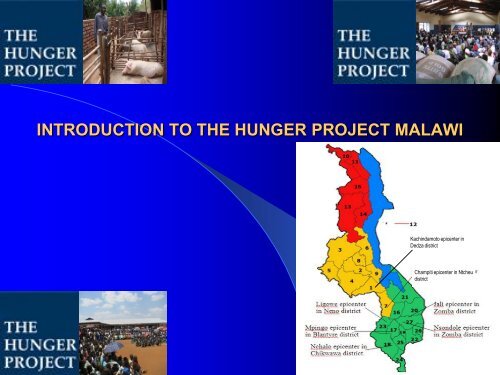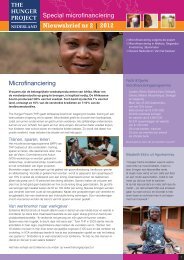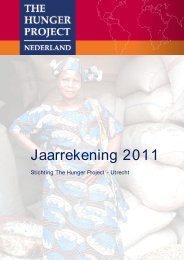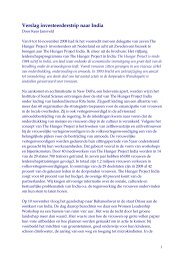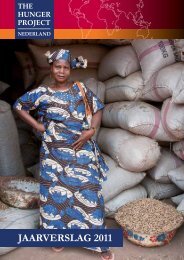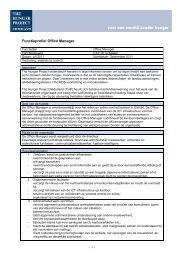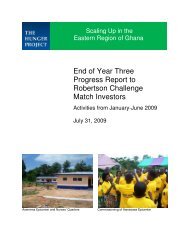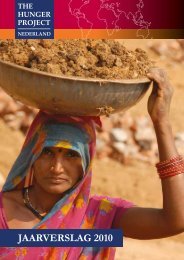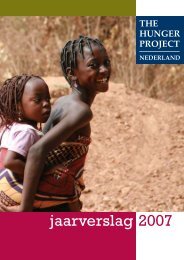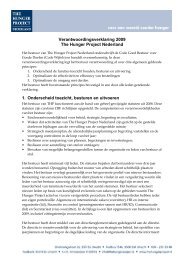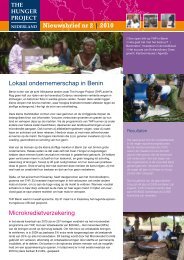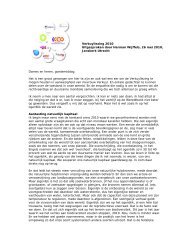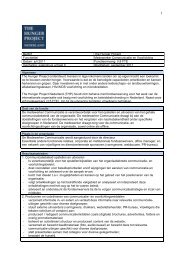introduction to the hunger project malawi
introduction to the hunger project malawi
introduction to the hunger project malawi
You also want an ePaper? Increase the reach of your titles
YUMPU automatically turns print PDFs into web optimized ePapers that Google loves.
INTRODUCTION TO THE HUNGER PROJECT MALAWI<br />
Kachindamo<strong>to</strong> epicenter in<br />
Dedza district<br />
Champiti epicenter in Ntcheu<br />
district
PRESENTATION OVERVIEW<br />
1. A brief on Malawi’s socio-economic profile<br />
2. Epicenter strategy (VCA – <strong>the</strong> process)<br />
3. Epicenter Strategy – A brief on tangible results<br />
4. Challenges
1. A BRIEF ON MALAWI’S SOCIO-ECONOMIC PROFILE<br />
Total population = 14-million (85% rural-based). Agro-based-economy<br />
Poverty levels : 40% below poverty line (2008)<br />
52% below poverty line (2006)<br />
65.3% below poverty line (2002)<br />
National literacy rate (58%) but lower for women (44%)<br />
IMR : 100/1000 live births (2008)<br />
225/1000 live births (1990)<br />
MMR :1,120/100000 pregnant women<br />
HIV national prevalence rate : 14% (2009) moving from 16% (2003)<br />
Inflation : 7.9% (2007) moving from 11.5% (2002)<br />
Economic growth rate : 9.7% (2008), up from 8.5% (2006) up from 1%<br />
(2003)
Some conclusions on Socio-economic profile<br />
• Fac<strong>to</strong>rs blamed for <strong>hunger</strong> & poverty in Malawi are complex<br />
• Communities do not restrict <strong>the</strong> definition of <strong>hunger</strong> and poverty <strong>to</strong><br />
issues of food and money only<br />
• Au<strong>the</strong>ntic community ownership and empowerment is key <strong>to</strong><br />
sustainable development in Malawi<br />
• As such a holistic approach, which promotes au<strong>the</strong>ntic<br />
community participation, ownership & empowerment,<br />
<strong>to</strong>wards <strong>the</strong> end of <strong>hunger</strong> & poverty appears <strong>to</strong> be <strong>the</strong><br />
best way forward<br />
• The Epicenter Strategy “provides <strong>the</strong> magic”
2. Epicenter strategy (VCA – The process)<br />
• Vision, Commitment and Action (VCA) Village Workshops.<br />
Conducted in all villages before and during implementation.<br />
• 5-principles established during VCAs<br />
Change of Mindset.<br />
Good Leadership.<br />
Vision creation.<br />
Commitment.<br />
Action.<br />
Partner village 6<br />
Partner village 1<br />
Partner village 2<br />
Epicenter structure<br />
Partner village 5 Partner village 3<br />
Partner village 4
3. Epicenter Strategy – Results Highlights<br />
A. Food Security: Average yields have improved from 600kgs <strong>to</strong> 2,000kgs<br />
per acre per HH per growing season (an average HH of 5 people needs 1,500-kgs<br />
maize per year).<br />
Jali<br />
Mr & Mrs Pemba’s maize<br />
production capacity has moved<br />
from 1,250kgs (2001) <strong>to</strong> 5,200kgs<br />
(2005)<br />
more than 40 bags of<br />
1.8%<br />
31 <strong>to</strong> 40 bags of 50-<br />
3.6%<br />
21 <strong>to</strong> 30 bags of 50-<br />
3.6%<br />
16 <strong>to</strong> 20 bags of 50-<br />
10.7%<br />
Ligowe 2005 Ligowe 2009<br />
more than 40 bags of<br />
5.4%<br />
1 <strong>to</strong> 10 bags of 50-k<br />
19.6%<br />
31 <strong>to</strong> 40 bags of 50-<br />
21.4%<br />
11 <strong>to</strong> 15 bags of 50-<br />
14.3%<br />
11 <strong>to</strong> 15 bags of 50-<br />
16.1%<br />
1 <strong>to</strong> 10 bags of 50-k<br />
64.3%<br />
21 <strong>to</strong> 30 bags of 50-<br />
23.2%<br />
16 <strong>to</strong> 20 bags of 50-<br />
16.1%
State President visit <strong>to</strong> Nsondole Epicenter<br />
Community Food Bank in 2005<br />
Irrigation farming: Enabling farmers <strong>to</strong> harvest twice in one year without depending on rainfall<br />
Nchalo epicenter
B. Micro-finance<br />
•There is now Malawi’s First Rural Women owned SACCO in Nsondole epicenter<br />
•There is evidence of women economic empowerment i.e women able <strong>to</strong> financially<br />
support <strong>the</strong>ir households, pay school fees for <strong>the</strong>ir children, buy medicines for <strong>the</strong>ir<br />
homes, improve <strong>the</strong>ir homes or build new houses, open savings accounts and<br />
continuously save money, improve <strong>the</strong>ir household food production
•2001 •2004<br />
Micro-finance support <strong>to</strong> PLWHIV piloted in Nchalo now scaled-up <strong>to</strong> o<strong>the</strong>r epicenters: Mrs<br />
Mulonda-below- of Nchalo now running a water kiosk & a hawker. They’ve also built a house which<br />
<strong>the</strong>y are renting out.
C. Combat HIV/AIDS, Malaria & o<strong>the</strong>r diseases<br />
585 (50% men, 50% women,<br />
50% youths) HIV/AIDS<br />
specialized Anima<strong>to</strong>rs trained.<br />
VBW have created a platform<br />
for among o<strong>the</strong>rs modification<br />
of endangering Cultural<br />
practices i.e “Kulowa Kufa” –<br />
Kutulo 1 village, Nchalo<br />
epicenter.
• Access and use of HIV & AIDS preventative and treatment services improved:<br />
• We’ve partnered with MACRO <strong>to</strong> provide Village-Mobile-HTC since 2006<br />
(now migrating <strong>the</strong> partnership <strong>to</strong> GOM-DHOs for sustainability purposes)<br />
• Engaged with local government structures <strong>to</strong> improve <strong>the</strong> proportion of <strong>the</strong><br />
rural population accessing and using ARTs. One outstanding result is<br />
Ntcheu DHO who opened Champiti Epicenter dispensary as a mobile ART<br />
Outreach center in 2009, now adopted by Ligowe and Nchalo epicenters
• Communities now able <strong>to</strong> access basic health<br />
services including Family Planning, treatment for<br />
malaria & o<strong>the</strong>r diseases i.e a <strong>to</strong>tal of 20,319-people<br />
(6,814-males and 13,505-females) received treatment at <strong>the</strong><br />
Ligowe epicenter dispensary alone from April <strong>to</strong> June 2010);<br />
• Communities now able <strong>to</strong> access vaccination<br />
services for under-five children i.e a <strong>to</strong>tal of 417-<br />
children were immunized (190-males, 227-Females) at<br />
Nsondole epicenter dispensary alone from April <strong>to</strong> June 2010 )<br />
• Free distribution by <strong>the</strong> Government of Antimalaria<br />
Insecticide Treated nets (ITNs) in<br />
epicenter clinics
Early & Adult Education<br />
2000/2001 2001/2002 2002/2003<br />
JALI 53.1% 60.2% 70.2%<br />
NCHALO 29.2% 33.4% 36%
ACCESS TO SAFE DRINKING WATER<br />
• Objective: To improve communities access <strong>to</strong> safe and portable water<br />
• 75.9% (Jali), 81.8% (Nsondole), 87.1% (Nchalo, 91.4% (Ligowe),<br />
91.8% (Mpingo), 95% (Champiti), 97% (Kachindamo<strong>to</strong>) have access<br />
<strong>to</strong> safe & portable water
4 : CHALLENGES<br />
Impact deep but not wide-spread due <strong>to</strong> financial limitations<br />
Resistance <strong>to</strong> accept <strong>the</strong> qualitative results of VCA workshop as a<br />
tangible result<br />
The deep rooted spirit of hand-outs in some areas delaying <strong>the</strong> speed<br />
of progression from phase one<br />
Contradic<strong>to</strong>ry messaging (quick fix or slow but sustainable fix)<br />
NUMBER OF EPICENTERS<br />
8<br />
7<br />
6<br />
5<br />
4<br />
3<br />
2<br />
1<br />
0<br />
7 7<br />
6<br />
5 5<br />
4 4<br />
2 2 2 2<br />
1999 2000 2001 2002 2003 2004 2005 2006 2007 2008 2009
Thank you very much!!


